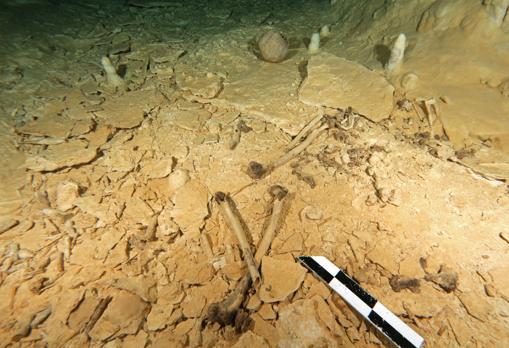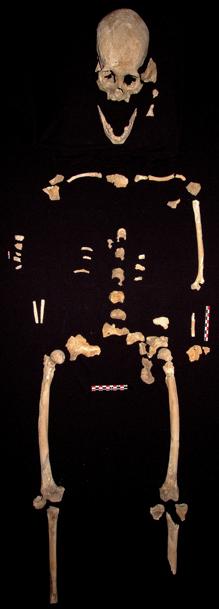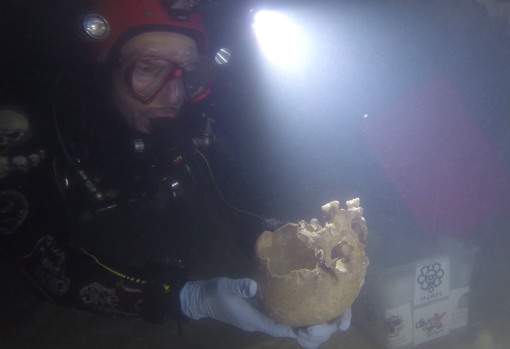Nearly 10,000 years ago, the body of a young woman ended up in a dry cave in southern Mexico. Her remains may shed light on the earliest settlers of the New World
TULUM Quintana Roo – In southern Mexico, in the Yucatan Peninsula a flooded cave has held the remains of a 10,000-year-old prehistoric girl. She was 1.64 meters tall, who ended her life in a not very pleasant way, suffering from a bacterial infection and with several traumas to her head.
“Ixchel” is the name given to the skeleton by the international team who discovered he remains, led by geoscientists from the University of Heidelberg Germany. The considerably well-preserved remains have physical characteristics that distinguish them from other American groups, which may shed light on the history of the continent’s first inhabitants.
The Pleistocene skeleton was discovered in the vicinity of Tulum Quintana Roo, about eight meters deep in fresh water and 1,141 meters from the entrance of the “Chan Hol” cave –in Mayan, means “small well”–, a cenote that was flooded as a result of rising sea levels approximately 8,000 years ago.

The skeletons were found in the underwater cave of Chan Hol, near Tulum – Eugenio Acevez
Nine other prehistoric skeletons had already been found in the last 20 years in this intricate system of submerged caves near the coast, including that of the famous “Naia“, a young woman at least 12,000 years old whose DNA, released in 2017, suggested that the first inhabitants of the new world arrived in a single migration from Asia across the Bering Strait.
“Ixchel” is the third Premaya individual in Chan Hol cave, between 10,000 and 13,000 years old.
The skeletons of Tulum offer valuable archaeological information. For example, all of them exhibit round head -mesocephalic- cranial characteristics, different from the long head -dolychocephalic- morphology of the Paleo-Indians of Central Mexico and North America, explains the professor. “Ixchel”, named after the Mayan goddess of fertility, wisdom and medicine, is no different.
For the researchers, the shape of the head is an indication that at least two morphologically different groups of Paleo-Indians lived in North America at the same time. They were able to reach the American continent from different geographical points of origin. But, as they write in the journal PLOS ONE, it is also possible that a small group of early settlers lived in isolation in the Yucatan Peninsula and developed a different skull morphology in a short period of time.
The history of the first settlements in the Americas would therefore be more complicated and may go back earlier than commonly believed.

Prehistoric skeleton pieces – Jerónimo Avilés Olguín
Cavities and an infection
Reaching the remains of “Ixchel” was not easy, according to Jerónimo Avilés Olguin, head of the team of speleodivers who recovered the remains and, as he emphasizes, “a Spaniard, a grandson of Madrid born in Mexico.
“It was quite a challenge, because of the remoteness of the site – 65- or 70-minutes swimming at a good pace – and once there you need hours of work,” he says. The divers used Dive-Xtras propulsion vehicles to save time and air. “Only two people can fit in the cave. Besides, it’s a very low place, barely a meter from the ceiling to the floor. And the visibility is quickly ruined. It only takes about four breaths and the water, the clearest you have ever seen, turns into horchata”, Avilés Olguin explains. The discoverers of the skeleton were the Mexican Iván Hernández and Spaniard, Vicente Fito.
Fortunately, 30% of the skeleton was very well preserved, showing a good part of the skull, the complete jaw, most of its long bones and bones as small as the hand phalanges. However, it is extremely fragile. “Its preservation was not as good compared to individuals found in caves with a greater depth and salt water, where there is no water flow as in fresh water at a shallow depth.” recalls Avilés.
The woman was approximately 30 years old at the time of her death. “She apparently met an unhappy end because she suffered from extensive caries and a serious bacterial disease, as well as three traumas to her skull,” says Wolfgang Stinnesbeck, leader of the research team. Indeed, the young woman’s skull had multiple wounds and a possible bacterial infection (of treponema) caused severe alteration of the cranial bones. Like the other skeletons of Tulum, the teeth had cavities, possibly due to a high sugar diet. In contrast, the teeth of most Paleo-Indian skeletons in central Mexico and North America are worn and decay-free, suggesting that they ate hard foods.
Diverse populations
To accurately date the finding, the researchers used a dating method based on the radioactive decay of uranium and its conversion to thorium. In this way, they dated the uranium-thorium isotopes from a lime crust that had grown on the finger bones in the originally dried out Chan Hol cave. Norbert Franck and his team at the Institute of Environmental Physics at the University of Heidelberg believe the skeleton is at least 9,900 years old. However, the body was already skeletonized and the prehistoric find may be even older.

Spanish paleodiver Vicente Fito holds the skull of “Ixchel”
For the researchers, this and the rest of Tulum’s skeletal findings demonstrate the unexpectedly early settlement of southern Mexico. “This new research tells us that the first inhabitants of the Americas were biologically very diverse and that perhaps the original settlement occurred in much earlier times than is now thought, as it takes sufficient time to obtain these morphological differences in human populations,” explains Silvia González, professor of Quaternary Geology and Geo-Archaeology at John Moores University in Liverpool.
The Yucatan Times
Newsroom



